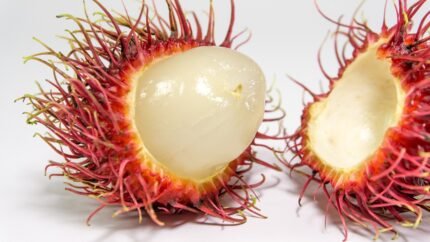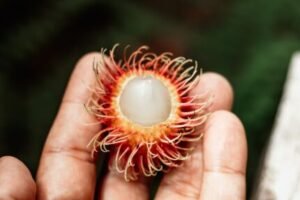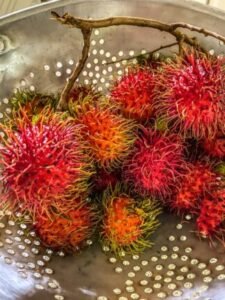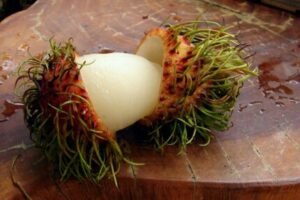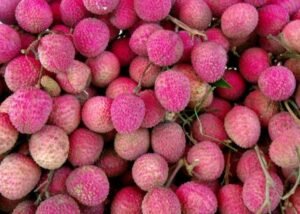Medically reviewed by Dr. Ramesh Gaddam, M.D. — Written by Sumalatha, D.N.H.E
Rambutan is a tropical fruit that is native to Southeast Asia. It is closely related to the lychee and longan and is known for its sweet and juicy flesh. The rambutan tree produces clusters of oval or round fruits, each with a hairy or spiky outer skin that can range in color from green to yellow or red. The fruit is typically about the size of a golf ball. Let’s learn the health benefits of Rambutan in detail.
1. Rambutan Nutrition
Nutritional profile for 100 grams of fresh rambutan fruit:
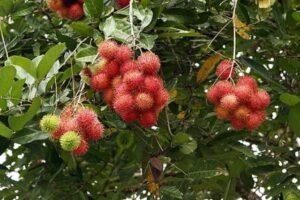
| Nutrient | Amount per 100g |
|---|---|
| Calories | 68 calories |
| Protein | 0.35 grams |
| Carbohydrates | 16.5 grams |
| Dietary Fiber | 0.9 grams |
| Sugars | 9.2 grams |
| Fat | 0.2 grams |
| Vitamin C | 20.9 mg (35% DV) |
| Calcium | 22 mg (2% DV) |
| Iron | 0.35 mg (2% DV) |
| Potassium | 42 mg (1% DV) |
2. Rambutan Benefits
Rich in Antioxidants:
Rambutan is a good source of antioxidants, particularly vitamin C. Antioxidants help protect your cells from damage caused by free radicals, which can contribute to aging and various diseases.
Boosts Immune System:
The high vitamin C content in rambutan can help boost your immune system, making you less susceptible to common illnesses like colds and flu.
Aids in Digestion:
Rambutan contains dietary fiber, which can aid in digestion by promoting regular bowel movements and preventing constipation.
Provides Hydration:
Rambutan has a high water content, which can help keep you hydrated, especially in hot, tropical climates.
Low in Calories:
Rambutan is relatively low in calories and fat, making it a healthy snack option for those looking to manage their weight.
Supports Skin Health:
The antioxidants in rambutan can help protect your skin from damage caused by UV rays and pollution. Additionally, vitamin C is important for collagen production, which is essential for healthy skin.
May Improve Bone Health:
Rambutan contains small amounts of calcium and phosphorus, which are important for maintaining strong bones.
Anti-Inflammatory Properties:
Some studies suggest that the fruit may have anti-inflammatory properties, which could be beneficial for conditions involving inflammation.
May Help Regulate Blood Pressure:
Rambutan contains potassium, which is known for its role in helping regulate blood pressure. However, it should not be considered a primary treatment for hypertension.
May Aid in Weight Management:
The fiber in rambutan can help you feel full and satisfied, potentially aiding in weight management when consumed as part of a balanced diet.
3. Rambutan Uses
Rambutan is primarily consumed as a delicious and refreshing tropical fruit, but it has various other uses as well:
Fresh Consumption
The most common use of rambutan is eating it fresh. To enjoy the fruit, you simply peel away the spiky skin to reveal the sweet and juicy flesh inside. It’s a popular snack in Southeast Asia.
Fruit Salads
Rambutan is often added to fruit salads, both for its sweet taste and its attractive appearance. It can add a burst of flavor and a unique texture to fruit salads.
Canned and Preserved
Rambutan can be canned or preserved in syrup to extend its shelf life. Canned rambutan can be used in desserts or eaten on its own.
Jams and Jellies
Rambutan can be used to make jams, jellies, and fruit preserves. Its sweet and tangy flavor makes it a good ingredient for these products.
Desserts
Rambutan can be used in various desserts, such as puddings, ice creams, sorbets, and tarts. The sweet and juicy nature of the fruit complements dessert recipes.
Beverages
Rambutan can be used to make fruit juices, smoothies, and cocktails. Its sweet and slightly acidic flavor can add a tropical twist to beverages.
Medicinal Uses
In traditional medicine, various parts of the rambutan tree have been used for their potential medicinal properties.
For example, the bark and leaves have been used in some cultures to treat ailments like dysentery and fever, although more scientific research is needed to confirm their efficacy.
Cosmetics
Some skincare products and cosmetics may contain rambutan extract or oil due to its antioxidant properties, which can be beneficial for skin health.
Dye
The bark of the rambutan tree has been used as a source of natural dye in some cultures. It can produce various colors, depending on the mordants and processes used.
Ornamental Plant
Rambutan trees are sometimes grown for their ornamental value in addition to their fruit-bearing capabilities.
The clusters of colorful fruit and the tree’s lush foliage make it an attractive addition to gardens and landscapes in tropical regions.
4. Rambutan Side Effects
Rambutan is generally safe to consume when eaten in moderation. However, as with most foods, there can be potential side effects or considerations, especially in certain circumstances:
Allergic Reactions:
Some individuals may be allergic to rambutan. Allergic reactions can range from mild symptoms like itching or skin rashes to more severe reactions, such as difficulty breathing or anaphylaxis.
If you have a history of allergies to fruits like lychee or longan (which are related to rambutan), it’s advisable to exercise caution when trying rambutan for the first time.
Digestive Upset:
Eating large quantities of rambutan or consuming unripe fruit can lead to digestive discomfort.
This may include stomach ache, diarrhea, or bloating. It’s best to eat rambutan in moderation and opt for ripe fruit.
High Sugar Content:
Rambutan is sweet due to its natural sugar content. If you have diabetes or are concerned about your blood sugar levels, you should monitor your intake of sweet fruits, including rambutan.
It’s advisable to consult with a healthcare professional or a registered dietitian for personalized dietary guidance.
Dental Health:
Like many sweet fruits, consuming rambutan can contribute to dental issues, particularly if consumed in excess.
The natural sugars in the fruit can promote tooth decay, so it’s important to practice good oral hygiene.
Pesticide Residues:
In some regions, rambutan may be treated with pesticides or other chemicals during cultivation.
To minimize the risk of pesticide exposure, it’s best to wash the fruit thoroughly before consumption. Buying organic or sustainably grown rambutan may also be an option.
Interactions with Medications:
If you are taking medications or have specific health conditions, there is the potential for interactions between rambutan and your medication.
For instance, if you’re on blood-thinning medication, you should be cautious with foods high in vitamin K, which rambutan contains in small amounts.
Always consult with your healthcare provider if you have concerns about interactions.
5. Rambutan vs lychee
Rambutan and lychee are both tropical fruits that share some similarities, but they also have distinct differences. Here’s a comparison of rambutan and lychee:
| Aspect | Rambutan | Lychee |
|---|---|---|
| Appearance | Hairy or spiky outer skin, typically red or yellow, sometimes green. Reveals translucent, juicy flesh with a single seed. | Rough, bumpy outer skin, typically red or pink when ripe. Reveals juicy, white or translucent flesh with a large seed. |
| Taste and Texture | Sweet and slightly acidic flavor with a juicy and somewhat crunchy texture. | Sweet with a floral, perfumed taste and a more tender, jelly-like texture. |
| Nutritional Content | Higher in vitamin C; low in calories and fat; provides antioxidant properties. | Higher in potassium and fiber; also low in calories and fat; provides antioxidant properties. |
| Geographic Origin | Native to Southeast Asia; commonly grown in Indonesia, Malaysia, the Philippines, and Thailand. | Native to Southeast Asia, with origins in southern China; also grown in similar regions to rambutan. |
| Culinary Uses | Enjoyed fresh, in fruit salads, desserts, juices, and various recipes. | Enjoyed fresh, in fruit salads, desserts, juices, and various recipes. |
| Availability | In season from late spring to early summer. | In season from late spring to early summer. |
| Allergies | Possible allergies; cross-allergies with lychee are possible due to similar botanical relationships. | Possible allergies; cross-allergies with rambutan are possible due to similar botanical relationships. |
In summary, while both rambutan and lychee are tropical fruits with sweet and juicy flesh, they differ in appearance, flavor, texture, and nutritional content.
6. Taste of Rambutan
Rambutan is a tropical fruit with a mostly sweet flavor that comes from its natural sugars. Its taste can be a bit different depending on how ripe it is, but even less ripe rambutans are still sweet.
The fruit is very juicy, giving you a burst of refreshing liquid when you bite into it.
There’s also a slight tanginess that adds a bit of balance to the sweetness. Some rambutans have a hint of floral notes, similar to lychee, which adds to its unique flavor.
Occasionally, if the fruit isn’t fully ripe, it might taste a bit dry or puckery, but this goes away as it ripens.
Rambutan is popular as a fresh snack or in fruit salads and desserts, making it a cool and tasty treat, especially in hot climates.
7. Rambutan during pregnancy
During pregnancy, it’s best to eat rambutan in moderation to avoid too much sugar and calories.
Some people might be allergic to rambutan or similar fruits like lychee, so if you’re unsure, check with your doctor.
Always wash rambutan thoroughly before eating to get rid of any dirt or chemicals.
If you notice any digestive issues, like bloating or diarrhea, it’s wise to limit or avoid rambutan until your digestive system feels better.
Rambutan is good for you because it has vitamin C, which supports your immune system and keeps you hydrated, but it’s important to eat a variety of fruits and vegetables to get all the nutrients you need.
For any specific dietary concerns or health conditions, consulting with your healthcare provider is a good idea to ensure you’re meeting your nutritional needs.
8. Rambutan calories
Rambutan is relatively low in calories, making it a healthy and refreshing snack option.
- The calorie content in 100 grams of fresh rambutan fruit is approximately 68 calories
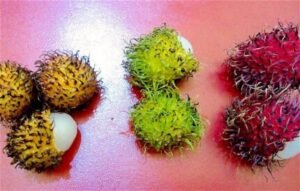
9. Rambutan varieties
Rambutan, like many fruits, has several different varieties, each with its unique characteristics in terms of appearance, taste, and fruit quality. While there are many rambutan cultivars, some of the more commonly known varieties include:
Rongrien
This is one of the most well-known rambutan varieties, often recognized by its red skin and sweet, juicy flesh.
Nephelium lappaceum
This standard rambutan variety features red or yellow skin and sweet, translucent flesh, and is often used as a reference for the species.
Lebak Bulus
Lebak Bulus rambutans are typically larger and known for their juicy, sweet flavor. They are popular in Indonesia.
Binjai
Binjai rambutans are small with green or yellow skin and have a sweet, slightly acidic taste.
Aceh
Grown in the Aceh region of Indonesia, Aceh rambutans are characterized by their sweet, juicy flesh and red skin.
Gula Batu
Gula Batu rambutans are sweet with a slightly acidic flavor and firm texture, commonly found in Medan, Indonesia.
Johor
Johor rambutans, from Malaysia, are recognized for their large size and sweet, juicy taste.
Tukad Petanu
Tukad Petanu rambutans, grown in Bali, Indonesia, are known for their sweetness and distinct flavor.
Chooi Ang
Chooi Ang rambutans from Malaysia are prized for their large size, sweet taste, and vibrant red skin.
Rapiah
Rapiah rambutans, with deep red skin, have a sweet flavor and are grown in Sumatra, Indonesia.
10. Rambutan benefits for skin
11. Rambutan benefits for sperm
12. Rambutan benefits for hair
13. Rambutan benefits for diabetes
Frequently Asked Questions (FAQs)
How to Eat Rambutan
To eat a rambutan, you need to peel away the spiky skin to reveal the translucent, juicy flesh inside.
The flesh has a sweet and slightly acidic flavor, and it usually contains a single seed in the center, which is not typically consumed.
Rambutans are often enjoyed fresh as a snack or added to fruit salads.
They are rich in vitamin C and other nutrients and are a popular fruit in many parts of Southeast Asia. The name “rambutan” is derived from the Malay word for “hairy,” which describes the fruit’s hairy exterior.
Rambutans are a delightful and refreshing tropical treat when they are in season.
Is rambutan good for health?
Yes, rambutan is considered a healthy fruit. It is rich in vitamin C and other essential nutrients.
The fruit provides antioxidants, promotes hydration, and can be part of a balanced diet. However, like all foods, it should be consumed in moderation.
Is rambutan the same as lychee?
Rambutan and lychee are related tropical fruits, but they are not the same.
While they share some similarities in taste and appearance, they have distinct differences.
Rambutan has hairy or spiky skin, whereas lychee has a rough, bumpy skin. The taste and texture of the flesh also have subtle variations.
Is it OK to eat rambutan every day?
Eating rambutan every day in moderation is generally safe for most people as part of a balanced diet. However, as with any food, variety is key to ensuring you get a wide range of nutrients from different sources.
What is the English name of rambutan?
Rambutan is the English name for the fruit. It is derived from the Malay word for “hairy,” which describes the fruit’s hairy exterior.
Can a diabetic eat rambutan?
Diabetics can eat rambutan, but they should be mindful of their overall carbohydrate intake, including the natural sugars found in the fruit.
It’s advisable for individuals with diabetes to monitor their blood sugar levels and consult with a healthcare professional or dietitian for personalized dietary guidance.
Is rambutan an Indian fruit?
Rambutan is not native to India, but it is grown in some parts of India, particularly in the southern states.
It is more commonly associated with Southeast Asian countries.
What are the two types of rambutan?
There are numerous rambutan varieties, but two well-known types are the red-skinned rambutan and the yellow-skinned rambutan.
These differ in terms of skin color, but taste and texture can also vary between varieties.
What is the cost of rambutan?
The cost of rambutan can vary widely depending on factors like location, seasonal availability, and local demand.
Prices can range from relatively inexpensive in regions where it is grown to more costly in areas where it is less common or imported.
What is the fruit with hairy skin?
Rambutan is the fruit with hairy or spiky skin.
Is it good to eat rambutan at night?
Eating rambutan at night is generally fine, just like eating fruit at any other time of the day.
It can be a refreshing and healthy snack. The key is to consume it in moderation and avoid excessive consumption close to bedtime to prevent discomfort.
Is rambutan hot or cold for the body?
In some traditional systems of medicine, rambutan is considered a “cooling” fruit, meaning it is thought to have a cooling effect on the body.
However, these concepts vary between cultures, and modern nutrition science does not strongly support such classifications.
Can babies eat rambutan?
Rambutan can be introduced to babies’ diets as they start eating solid foods, typically around 6 months of age.
It should be prepared in a way that minimizes choking hazards and is easy for the baby to digest. Consult with a pediatrician for guidance on introducing new foods to your baby’s diet.
What is another name for rambutan?
Rambutan is known by the same name in English, but it may be called different names in other languages. For example, in Malay, it’s also known as “rambutan.”
What is rambutan famous for?
Rambutan is famous for its sweet and juicy flesh, its spiky or hairy skin, and its popularity as a tropical fruit in Southeast Asian countries.
What country is Rambutan popular for?
Rambutan is particularly popular in Southeast Asian countries such as Indonesia, Malaysia, Thailand, the Philippines, and Vietnam. It is also grown and enjoyed in some other tropical regions.
Which state fruit is rambutan?
Rambutan is not an official state fruit in any U.S. state. It is primarily grown in tropical regions outside of the United States.
What is the lifespan of a rambutan tree?
A rambutan tree can have a lifespan of 15 to 30 years or more, depending on various factors like growing conditions, disease resistance, and maintenance.
What season is rambutan?
The rambutan season can vary depending on the region, but it is often in season during the late spring to early summer months in many tropical areas.
Is rambutan a lucky fruit?
Rambutan is not typically considered a “lucky fruit” in the same way some other fruits are regarded in certain cultures.
However, fruits like apples, oranges, and pomegranates are more commonly associated with symbolic meanings of luck and prosperity in various traditions.
How many rambutan can I eat in a day?
The number of rambutan you can eat in a day depends on various factors, including your overall dietary habits, nutritional needs, and personal preferences.
Rambutan is a healthy fruit, and consuming it in moderation is generally considered good for your health.
Is rambutan good or bad for you?
Is rambutan good for weight loss?
While rambutan is a healthy snack option, it’s not a miracle weight loss fruit.
Weight loss is primarily achieved through a calorie deficit (consuming fewer calories than you burn) and a balanced diet. Rambutan can be part of a weight loss diet as long as it is consumed in moderation.
What are the benefits of rambutan peel?
The peel of rambutan is not typically eaten due to its tough and inedible nature.
However, some people use rambutan peel in traditional medicine or skincare preparations. It contains certain phytochemicals and antioxidants, which are believed to have potential health benefits.
Is rambutan good for skin whitening?
There is no scientific evidence to suggest that eating rambutan or using its peel directly leads to skin whitening.
Skin color is primarily determined by genetics, and any claims of skin-whitening properties of rambutan should be taken with caution.
Skincare practices that promote overall skin health, such as protecting your skin from UV damage and maintaining a healthy diet, can contribute to a healthy complexion.
What is the deficiency of rambutan?
Rambutan is a nutritious fruit, and there is no specific deficiency associated with it.
However, rambutan, like all fruits, should be part of a balanced diet to ensure you get a wide range of essential nutrients. If you consume a variety of foods, you are less likely to experience deficiencies in specific nutrients.
When should I eat rambutan?
Rambutan is typically enjoyed as a snack or dessert.
You can eat it fresh when it is in season, which is usually during the late spring and early summer in many tropical regions. Rambutan is delicious when it’s ripe and has a sweet flavor.
Is it OK to eat rambutan seeds?
Rambutan seeds are generally not recommended for consumption. They have a hard, inedible shell and are considered unpalatable.
In some cases, the seeds may contain compounds that can be toxic if ingested in large quantities. It’s best to avoid eating rambutan seeds.
Which rambutan is best yellow or red?
The choice between yellow and red rambutan varieties is a matter of personal preference.
Both can be delicious, and the taste can vary between varieties, even within the same color group. Taste them to determine which you prefer.
Is rambutan rich in iron?
Rambutan contains a small amount of iron, but it is not considered a significant source of this mineral.
If you are looking to increase your iron intake, you might want to consider other foods that are richer in iron, such as lean meats, beans, lentils, and dark leafy greens.
References:
https://www.webmd.com/diet/health-benefits-rambutan
https://www.healthline.com/nutrition/rambutan
https://www.medicinenet.com/rambutan_nutrition_health_benefits_how_to_eat/article.htm
Also Read:
7 Red Lychee (Litchi) Health Benefits for Hair, Skin, Weight
Medically reviewed by Dr. Ramesh Gaddam, M.D.

General Physician, Diabetologist, and Critical Care Specialist.
Discover more from Health Build-Up
Subscribe to get the latest posts sent to your email.
